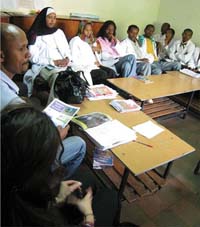14.3.1 Personnel or labour power
The key to any successful health education activities will always be the individuals needed to carry them out (Figure 14.6). You are the primary person to put health education activities into practice within your own community. However, it is difficult for you to carry out every task. So you should be able to identify volunteer individuals from the community, such as community leaders, kebele leaders and possibly religious leaders. In addition, leaders of different community organisations such as idir, iquib and mehber may be very helpful. They may be able to assist you in organising the community, arranging schedules for health education, mobilising the community for participation, and even possibly delivering health education sessions for their followers themselves.

Other non-governmental organisations may be available in your community, and may be important sources of personnel for your activities. They may be able to assist you in different ways. For example, they may help you to provide training for peer educators or for households. In addition, you could request the woreda Health Office to provide you with assistance on certain issues. For example, the woreda Health Office might be able to provide you with teaching materials.
Look back at Section 14.1 which was about organising people, and remind yourself about whether in this section you thought about leaders of idir, iquib and mehber and whether you thought about approaching the kebele administrator.
However you go about training people, it is obviously very important to get a sense of who community leaders think will be good peers to be involved in health education. Using this knowledge is key to being able to target useful and enthusiastic people. So make sure you use your networks of key people.
14.3 Identifying and mobilising resources for health education
